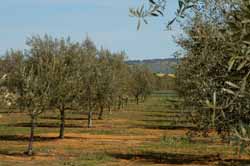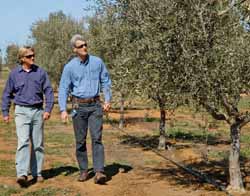They have been hailed by one of their guardians as Charles Sturt University’s (CSU) best kept secret, but the low key presence of olives at CSU may be about to end.
 Organised neatly in rows that blend in with surrounding farmland is the University’s Experimental Olive Grove, which is complemented by the much older Heritage Olive Grove located across the Wagga Wagga Campus near the CSU Winery.
Organised neatly in rows that blend in with surrounding farmland is the University’s Experimental Olive Grove, which is complemented by the much older Heritage Olive Grove located across the Wagga Wagga Campus near the CSU Winery. According to historical research by CSU Associate Professor Dirk Spennemann, olives from South Australia and Victoria were first planted in 1894 around what is now the CSU Winery. By the following year, eight acres of olive were recorded at the Wagga Experiment Farm. The heritage grove now contains 50 varieties in what is hailed as one of the largest olive gene pools in Australia.
Planted in 2000, the Experimental Grove in CSU’s horticultural precinct boasts 24 commercial olive varieties which have been randomly planted. Each of the 350 trees in the grove’s 21 rows has been tagged to allow CSU Technical Officer Mr Richard Early to collate detailed data on olive weight and olive yield from each tree.
“2008 represents a benchmark for the grove as olives were weighed for the first time and yield data collected,” said Mr Early. Picked commercially in May and June this year by local contractor Shane Cummins, some riper varieties were used in his oil under the label, ‘Long Paddock Olive Rustlers at Charles Sturt University’s Experimental Grove ’.
 “With 20 per cent of the varieties suitable for the table, the University is also pickling olives in the hope they will be bottled by the end of 2008 and sold as table olives through the CSU Winery’s cellar door,” said Mr Early.
“With 20 per cent of the varieties suitable for the table, the University is also pickling olives in the hope they will be bottled by the end of 2008 and sold as table olives through the CSU Winery’s cellar door,” said Mr Early. With enthusiasm waxing and waning throughout its existence, the heritage grove underwent a harsh cull in 1963 and was pruned severely a decade ago. The grove now outlines what was once the boundary fence of the Wagga Experiment Farm.
The olives from the Heritage grove have been used as table olives, in cooking oil and machinery oil,” said Mr David Thompson who oversees the heritage grove. “The trees stand tall and strong and have clearly adapted to the different human environments which have surrounded them over the past 100 years.”
“They are, I feel, the best kept secret at the University,” he said.
Mr Cummins said the heritage grove trees were amongst the oldest and grandest in Australia and were deeply entrenched in the psyche of growers in Australia. He now has the task of reshaping the heritage grove trees with careful pruning.
Demonstrating his confidence in the CSU olives, Mr Cummins has submitted his oil containing a selection of the varieties from each grove for judging by the Royal National Canberra Agricultural Society in late September.
 “The olives do well in Wagga Wagga because of the hot dry summer and moist winter and favourable soils with good drainage and neutral to alkaline sub-soil.”
“The olives do well in Wagga Wagga because of the hot dry summer and moist winter and favourable soils with good drainage and neutral to alkaline sub-soil.” While known for its award-winning cheeses and wines, CSU may soon add olives to that list of fine food products. Then the beauty of the University’s groves – old and new - may then be less of a secret.





Social
Explore the world of social